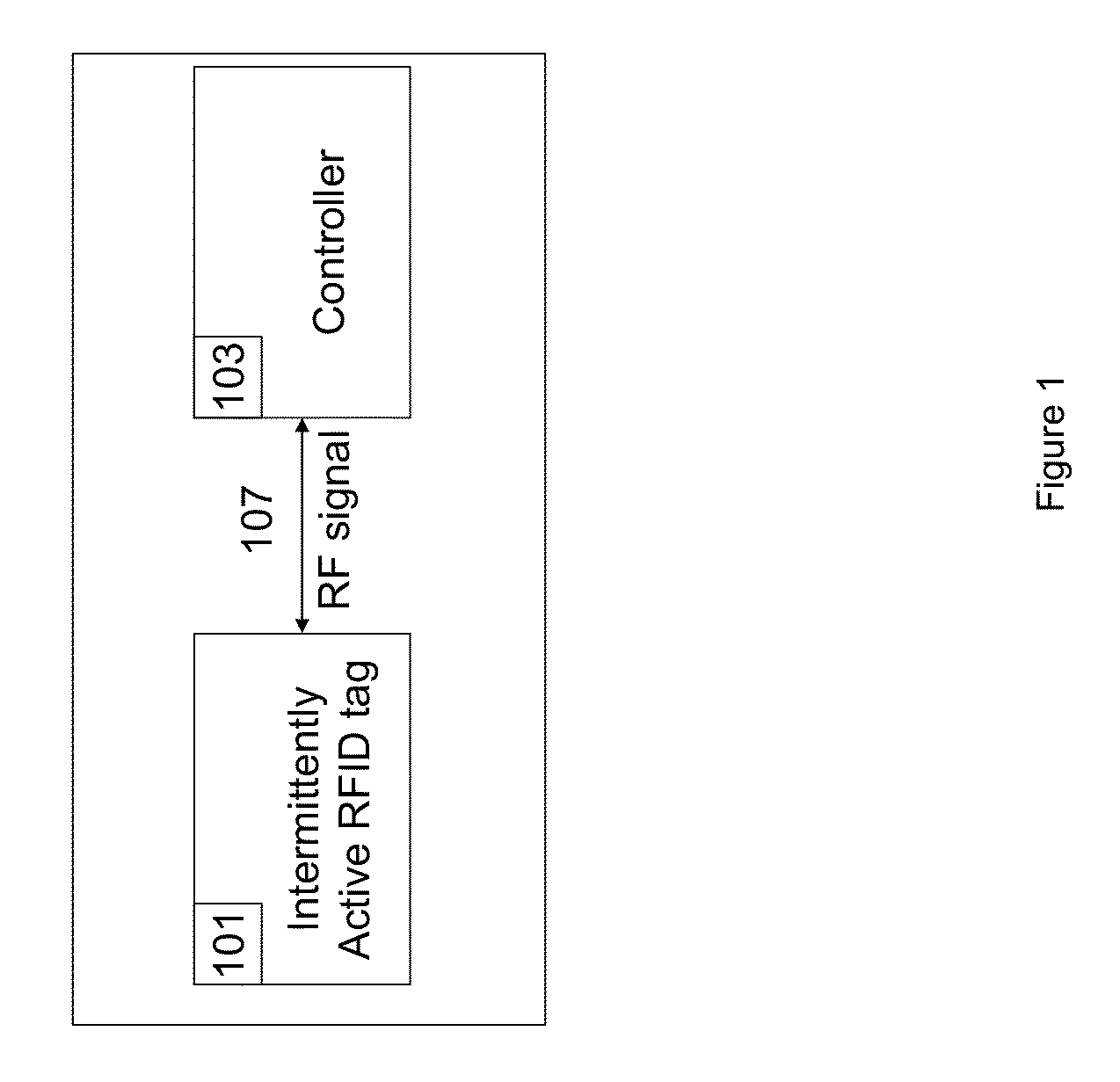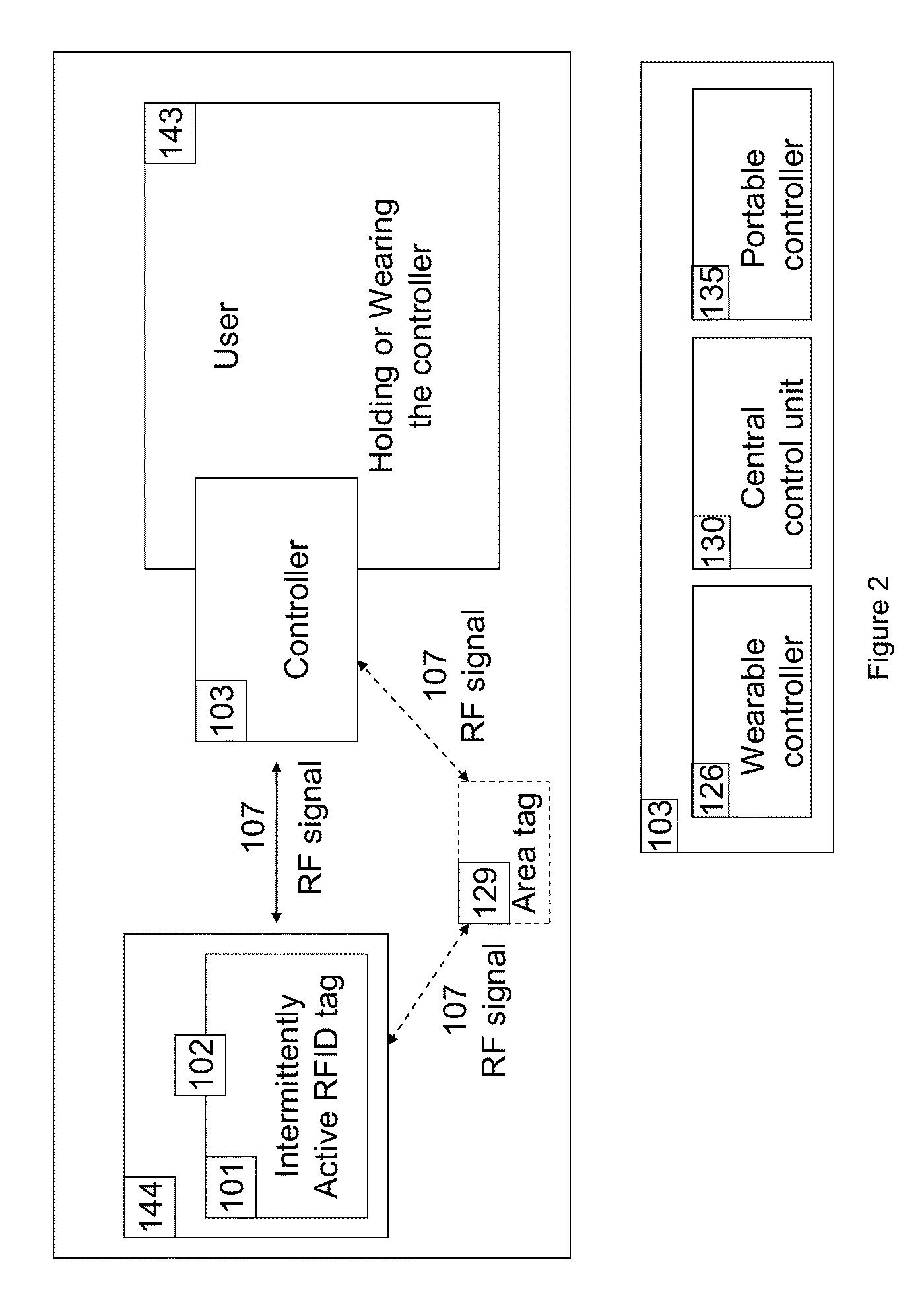Apparatus and method for locating, tracking, controlling and recognizing tagged objects using active RFID technology
a technology of active radio frequency identification and apparatus, applied in the field of intermittently active radio frequency identification (rfid) tags, can solve the problems of limitations of the prior, drawbacks of conventional rfid, and inability to detect objects, and achieve the effect of convenient operation
- Summary
- Abstract
- Description
- Claims
- Application Information
AI Technical Summary
Benefits of technology
Problems solved by technology
Method used
Image
Examples
embodiments
[0104]Controller: There are small wearable controllers 126, portable fob-like controllers 135, and central control unit controllers 130. The latter can configure the complete system by user input to its buttons or from a connected computer. All controllers consist of the hardware of the circuit 100 with microprocessor 108 and memory 120, an antenna 111, a power source 116, has input 121 and output 139. For 126 and 135, excluding the input / output mechanisms, the circuit is fully integrated into a housing 123 the user can wear, hold, or carry. The user can control other devices in the system by pushing a button or have other devices be controlled by the controller automatically. Control actions include tracking, switching on / off, lock / unlock, or report proximity to other devices.
[0105]Tag: The tag 101 consists of the hardware of the circuit 100 with microprocessor 108 and memory 120, antenna 111, a power source 116 and has one input of 104 / 105 / 132, and output 139. The circuit is fully...
example 1
Insider Threats
[0216]In the case of a rogue insider, the present invention has barriers to prevent data theft, even by highly skilled rogues. One feature is the autonomy of the present invention from an organization's IT department (hereinafter, “IT”). IT does not have control over this system, nor does it have an exemption; like everyone else, IT personnel are issued authorized USBs and not allowed to use personal devices. Their USBs and computers are linked to each other and to each employee's smart ID badge. There is a trend toward “BYOD” (Bring Your Own Device) to the work place and an opposite trend allowing employees to take laptops home; both pose enormous security risks, many of which are beyond the scope of the present invention, which can only enforce policies, not create them. The human factor is at the root of the mingling of personal matters and work. While there may be ways for the present invention to mitigate some of the risks, such as locating or tracking these devi...
example / embodiment
Example / Embodiment / Variation 4
Locks
[0227]Even very small amounts of critical data are taken for granted but at great risk. Vehicle entry systems, such as Remote Keyless Entry (RKE) and Passive Keyless Entry and Start (PKES) systems are ubiquitous for vehicles and moving into other applications, such as locks on a door. Unfortunately, these systems are vulnerable to attack.
[0228]With an active key, pressing a button opens the car and the metal key starts the car. The key must be relatively close (<100 m) and sends a one-way message to the car. The weakness is that the key and the car share the encryption key, but that cryptography is weak. The same is true of keys with immobilizer chips, which use passive RFID and require very close proximity, within centimeters. The remote opens the car and shares the cryptographic key with the vehicle, so here too there is a vulnerability of weak cryptography.
[0229]Passive Keyless Entry and Start (PKES) systems require the device to be within 2 to ...
PUM
 Login to View More
Login to View More Abstract
Description
Claims
Application Information
 Login to View More
Login to View More - R&D
- Intellectual Property
- Life Sciences
- Materials
- Tech Scout
- Unparalleled Data Quality
- Higher Quality Content
- 60% Fewer Hallucinations
Browse by: Latest US Patents, China's latest patents, Technical Efficacy Thesaurus, Application Domain, Technology Topic, Popular Technical Reports.
© 2025 PatSnap. All rights reserved.Legal|Privacy policy|Modern Slavery Act Transparency Statement|Sitemap|About US| Contact US: help@patsnap.com



